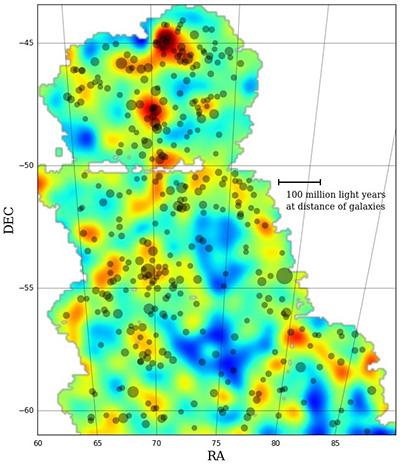Researchers map and unlock new secrets of dark matter

Swiss scientists have helped uncover a series of recent findings about the nature of dark matter in the universe, working on a team that found dark matter behaving in new ways and leading a project mapping its locations.
By observing four galaxies colliding simultaneously, a group of researchers from six countries, including Switzerland, revealed on Wednesday that for the first time, they had found dark matter interacting with itself through a force other than gravity.
Scientists had identified that dark matter creates gravity and is affected by gravity, but what it is made of and how other forces affect it have remained a mystery.
When observing the colliding galaxies from the European Southern Observatory in Chile, researchers saw something unusual: one clump of dark matter lagging 5,000 light-years behind the galaxy it surrounded. Such a lag during galaxy collisions only happens when the dark matter is interacting with a force other than gravity, a phenomenon that has never been observed by scientists until now.
“If dark matter were being slowed down during this collision, it could be the first evidence for rich physics in the dark sector — the hidden universe all around us,” said the study’s lead author Richard Massey in a press release.
The Swiss scientists involved in the observation of the dark matter collision come from the Physics Institute at the University of Zurich and the Swiss Federal Institute of Technology Lausanne (EPFL).
Mapping dark matter
Meanwhile, an international collaboration of scientists known as the Dark Energy Survey released a new detailed map of where dark matter can be found in the universe. Led by American and Swiss researchers, the group used a 570 megapixel “dark energy camera” to observe the effects of gravity on galaxies – the only way to see dark matter. The team specifically looked for slight distortions in images based on light from galaxies passing through various amounts of dark matter on its way to Earth.

“We measured these barely noticeable distortions in around two million galaxies to make this map,” said Vinu Vikram of the Argonne National Laboratory in the United States, who led the project together with Chihway Chang of the Swiss Federal Institute of Technology ETH Zurich.
The two million galaxies measured by the map make up only 3% of the sky we can see from Earth. Scientists believe that 95% of the universe is made up of dark matter and dark energy, the latter of which is believed to be responsible for the increasingly rapid expansion of the universe.
By mapping and comparing the amounts of dark and visible matter in the universe, scientists are testing one theory that galaxies are born wherever there are higher concentrations of dark matter –and therefore higher concentrations of gravity.
So far, the research team’s map seems to confirm that theory, since it shows long threads of dark matter bordered by visible galaxies and galaxy clusters between which can be seen large gaps with only few galaxies.

In compliance with the JTI standards
More: SWI swissinfo.ch certified by the Journalism Trust Initiative











You can find an overview of ongoing debates with our journalists here . Please join us!
If you want to start a conversation about a topic raised in this article or want to report factual errors, email us at english@swissinfo.ch.